PUBH6002 Report: Water Related Health Issues in Australia
VerifiedAdded on 2023/01/16
|9
|2042
|75
Report
AI Summary
This report examines water-related health issues impacting the Aboriginal and Torres Strait Islander communities in Australia. It explores the driving forces behind these issues, including historical deprivation, political oppression, and social marginalization, and their impact on access to clean water. The report analyzes the social, political, and economic influences, including the role of government policies and the economic situations of the indigenous people. It discusses management strategies implemented by health agencies and NGOs, focusing on awareness campaigns, sanitary surveys, and the implementation of programs like WASH FIT. The report also provides recommendations for addressing the challenges, such as abolishing barriers to water access, implementing sanitary surveys, and adhering to WHO guidelines. The conclusion highlights the ongoing efforts to address water scarcity and waterborne diseases, emphasizing the importance of collaborative approaches and continued governmental support.
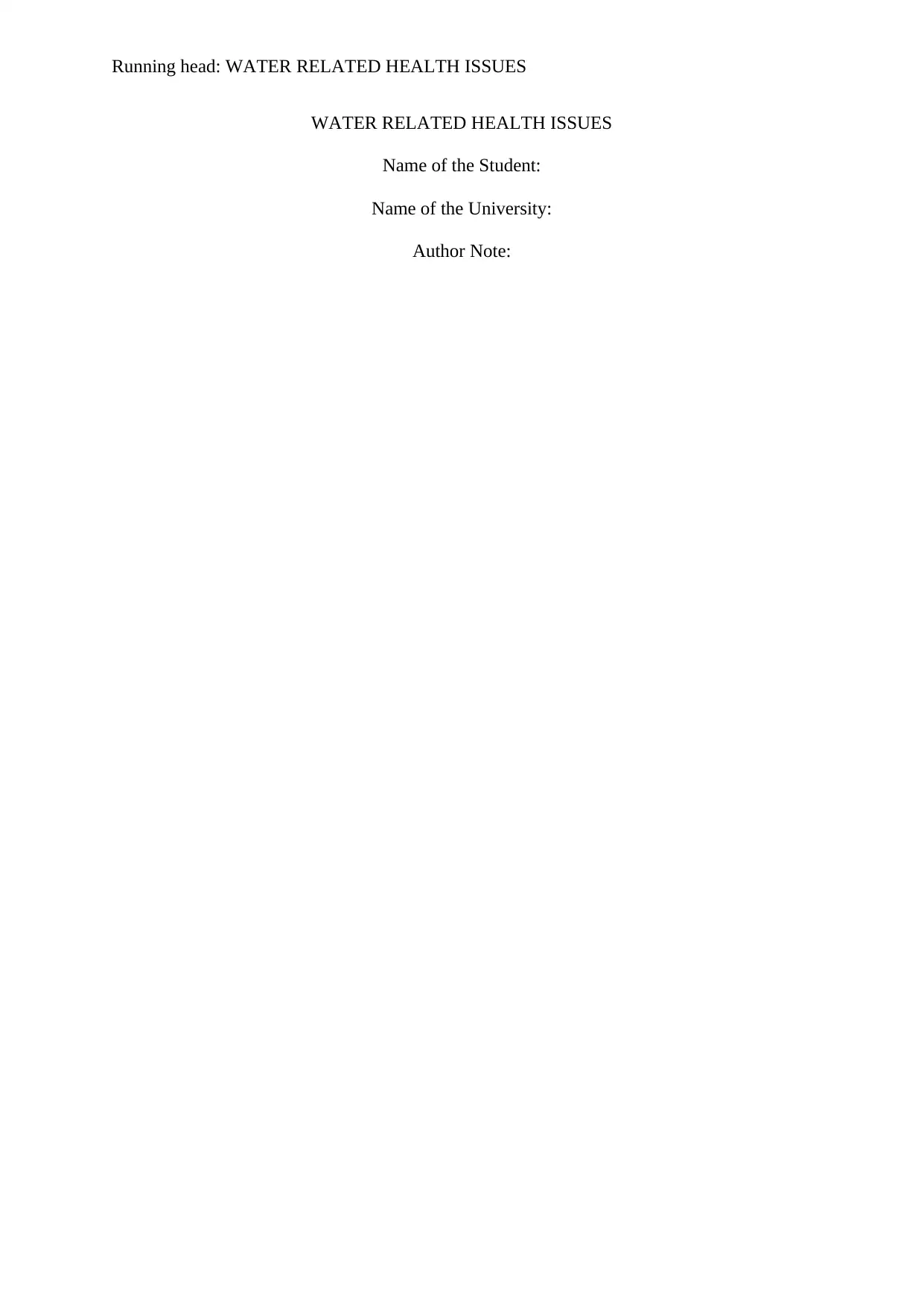
Running head: WATER RELATED HEALTH ISSUES
WATER RELATED HEALTH ISSUES
Name of the Student:
Name of the University:
Author Note:
WATER RELATED HEALTH ISSUES
Name of the Student:
Name of the University:
Author Note:
Paraphrase This Document
Need a fresh take? Get an instant paraphrase of this document with our AI Paraphraser
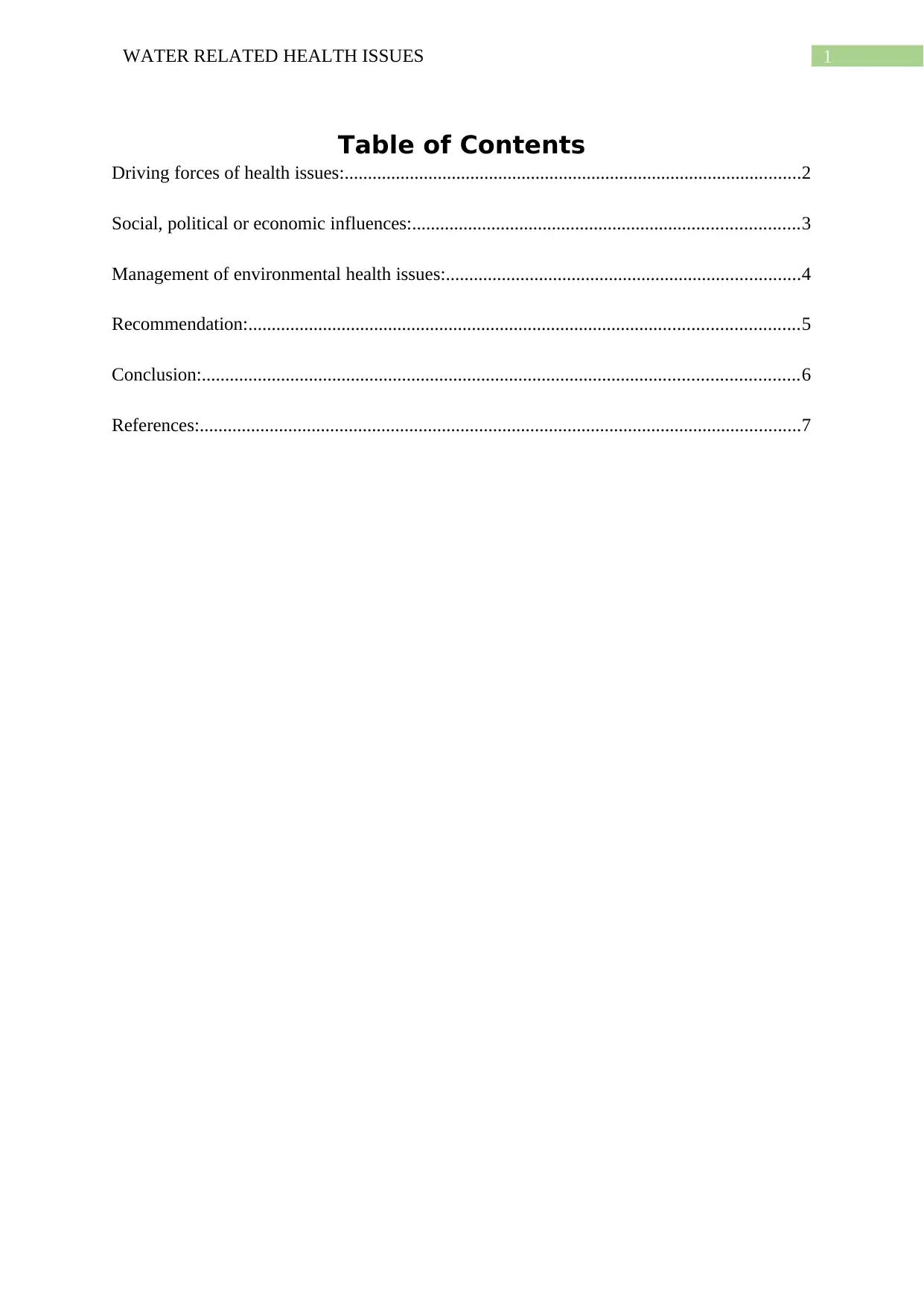
1WATER RELATED HEALTH ISSUES
Table of Contents
Driving forces of health issues:..................................................................................................2
Social, political or economic influences:...................................................................................3
Management of environmental health issues:............................................................................4
Recommendation:......................................................................................................................5
Conclusion:................................................................................................................................6
References:.................................................................................................................................7
Table of Contents
Driving forces of health issues:..................................................................................................2
Social, political or economic influences:...................................................................................3
Management of environmental health issues:............................................................................4
Recommendation:......................................................................................................................5
Conclusion:................................................................................................................................6
References:.................................................................................................................................7
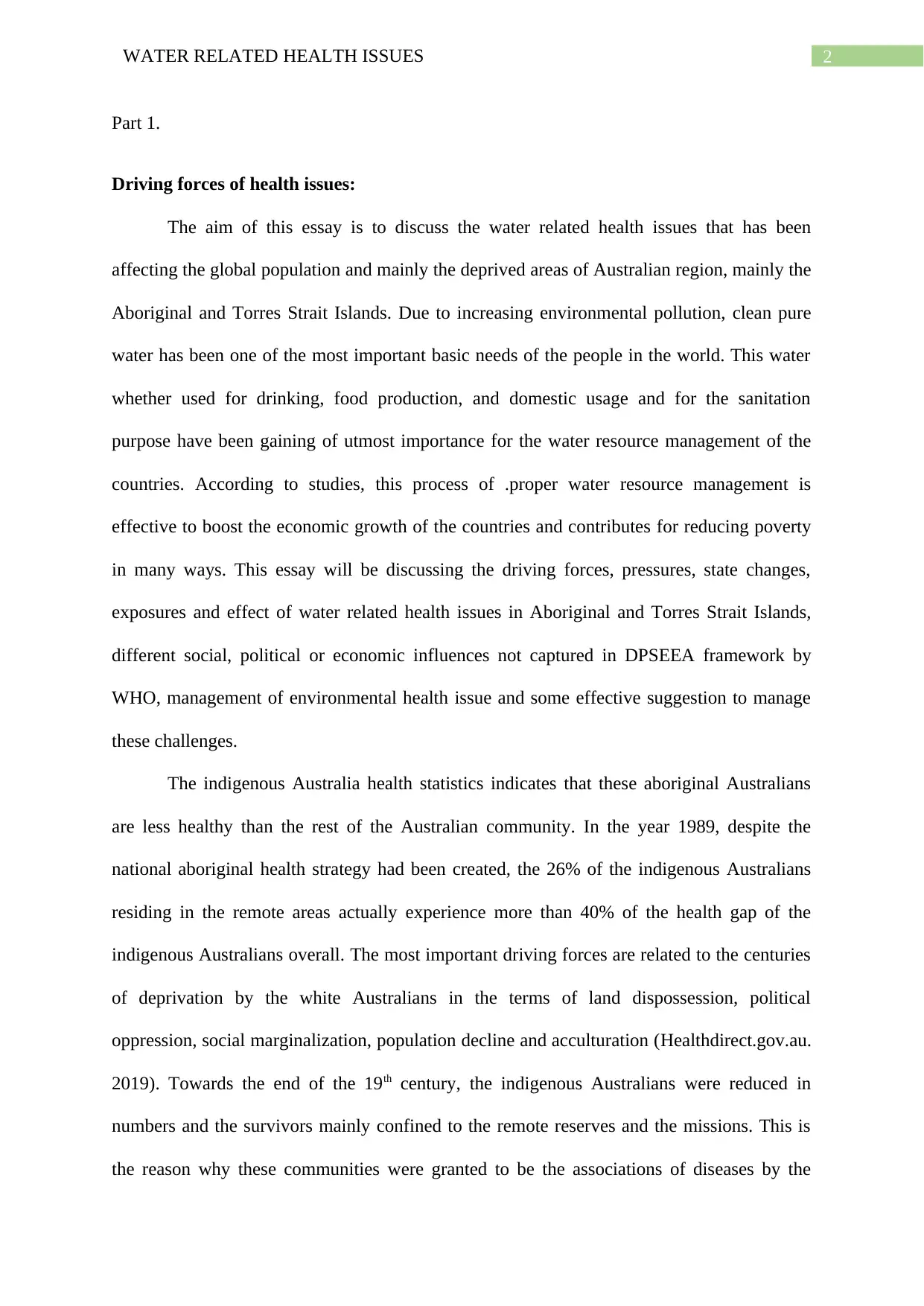
2WATER RELATED HEALTH ISSUES
Part 1.
Driving forces of health issues:
The aim of this essay is to discuss the water related health issues that has been
affecting the global population and mainly the deprived areas of Australian region, mainly the
Aboriginal and Torres Strait Islands. Due to increasing environmental pollution, clean pure
water has been one of the most important basic needs of the people in the world. This water
whether used for drinking, food production, and domestic usage and for the sanitation
purpose have been gaining of utmost importance for the water resource management of the
countries. According to studies, this process of .proper water resource management is
effective to boost the economic growth of the countries and contributes for reducing poverty
in many ways. This essay will be discussing the driving forces, pressures, state changes,
exposures and effect of water related health issues in Aboriginal and Torres Strait Islands,
different social, political or economic influences not captured in DPSEEA framework by
WHO, management of environmental health issue and some effective suggestion to manage
these challenges.
The indigenous Australia health statistics indicates that these aboriginal Australians
are less healthy than the rest of the Australian community. In the year 1989, despite the
national aboriginal health strategy had been created, the 26% of the indigenous Australians
residing in the remote areas actually experience more than 40% of the health gap of the
indigenous Australians overall. The most important driving forces are related to the centuries
of deprivation by the white Australians in the terms of land dispossession, political
oppression, social marginalization, population decline and acculturation (Healthdirect.gov.au.
2019). Towards the end of the 19th century, the indigenous Australians were reduced in
numbers and the survivors mainly confined to the remote reserves and the missions. This is
the reason why these communities were granted to be the associations of diseases by the
Part 1.
Driving forces of health issues:
The aim of this essay is to discuss the water related health issues that has been
affecting the global population and mainly the deprived areas of Australian region, mainly the
Aboriginal and Torres Strait Islands. Due to increasing environmental pollution, clean pure
water has been one of the most important basic needs of the people in the world. This water
whether used for drinking, food production, and domestic usage and for the sanitation
purpose have been gaining of utmost importance for the water resource management of the
countries. According to studies, this process of .proper water resource management is
effective to boost the economic growth of the countries and contributes for reducing poverty
in many ways. This essay will be discussing the driving forces, pressures, state changes,
exposures and effect of water related health issues in Aboriginal and Torres Strait Islands,
different social, political or economic influences not captured in DPSEEA framework by
WHO, management of environmental health issue and some effective suggestion to manage
these challenges.
The indigenous Australia health statistics indicates that these aboriginal Australians
are less healthy than the rest of the Australian community. In the year 1989, despite the
national aboriginal health strategy had been created, the 26% of the indigenous Australians
residing in the remote areas actually experience more than 40% of the health gap of the
indigenous Australians overall. The most important driving forces are related to the centuries
of deprivation by the white Australians in the terms of land dispossession, political
oppression, social marginalization, population decline and acculturation (Healthdirect.gov.au.
2019). Towards the end of the 19th century, the indigenous Australians were reduced in
numbers and the survivors mainly confined to the remote reserves and the missions. This is
the reason why these communities were granted to be the associations of diseases by the
⊘ This is a preview!⊘
Do you want full access?
Subscribe today to unlock all pages.

Trusted by 1+ million students worldwide
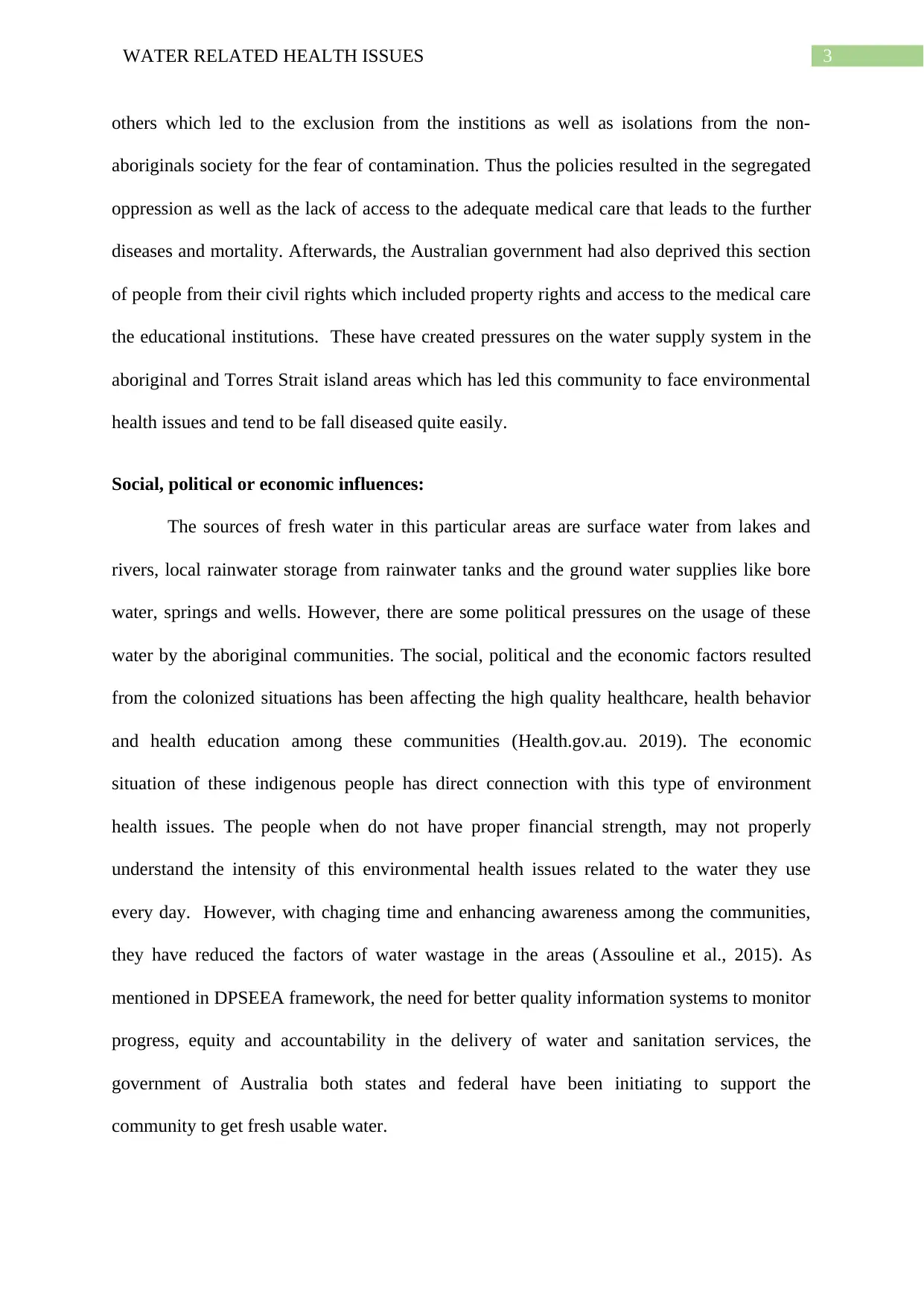
3WATER RELATED HEALTH ISSUES
others which led to the exclusion from the institions as well as isolations from the non-
aboriginals society for the fear of contamination. Thus the policies resulted in the segregated
oppression as well as the lack of access to the adequate medical care that leads to the further
diseases and mortality. Afterwards, the Australian government had also deprived this section
of people from their civil rights which included property rights and access to the medical care
the educational institutions. These have created pressures on the water supply system in the
aboriginal and Torres Strait island areas which has led this community to face environmental
health issues and tend to be fall diseased quite easily.
Social, political or economic influences:
The sources of fresh water in this particular areas are surface water from lakes and
rivers, local rainwater storage from rainwater tanks and the ground water supplies like bore
water, springs and wells. However, there are some political pressures on the usage of these
water by the aboriginal communities. The social, political and the economic factors resulted
from the colonized situations has been affecting the high quality healthcare, health behavior
and health education among these communities (Health.gov.au. 2019). The economic
situation of these indigenous people has direct connection with this type of environment
health issues. The people when do not have proper financial strength, may not properly
understand the intensity of this environmental health issues related to the water they use
every day. However, with chaging time and enhancing awareness among the communities,
they have reduced the factors of water wastage in the areas (Assouline et al., 2015). As
mentioned in DPSEEA framework, the need for better quality information systems to monitor
progress, equity and accountability in the delivery of water and sanitation services, the
government of Australia both states and federal have been initiating to support the
community to get fresh usable water.
others which led to the exclusion from the institions as well as isolations from the non-
aboriginals society for the fear of contamination. Thus the policies resulted in the segregated
oppression as well as the lack of access to the adequate medical care that leads to the further
diseases and mortality. Afterwards, the Australian government had also deprived this section
of people from their civil rights which included property rights and access to the medical care
the educational institutions. These have created pressures on the water supply system in the
aboriginal and Torres Strait island areas which has led this community to face environmental
health issues and tend to be fall diseased quite easily.
Social, political or economic influences:
The sources of fresh water in this particular areas are surface water from lakes and
rivers, local rainwater storage from rainwater tanks and the ground water supplies like bore
water, springs and wells. However, there are some political pressures on the usage of these
water by the aboriginal communities. The social, political and the economic factors resulted
from the colonized situations has been affecting the high quality healthcare, health behavior
and health education among these communities (Health.gov.au. 2019). The economic
situation of these indigenous people has direct connection with this type of environment
health issues. The people when do not have proper financial strength, may not properly
understand the intensity of this environmental health issues related to the water they use
every day. However, with chaging time and enhancing awareness among the communities,
they have reduced the factors of water wastage in the areas (Assouline et al., 2015). As
mentioned in DPSEEA framework, the need for better quality information systems to monitor
progress, equity and accountability in the delivery of water and sanitation services, the
government of Australia both states and federal have been initiating to support the
community to get fresh usable water.
Paraphrase This Document
Need a fresh take? Get an instant paraphrase of this document with our AI Paraphraser
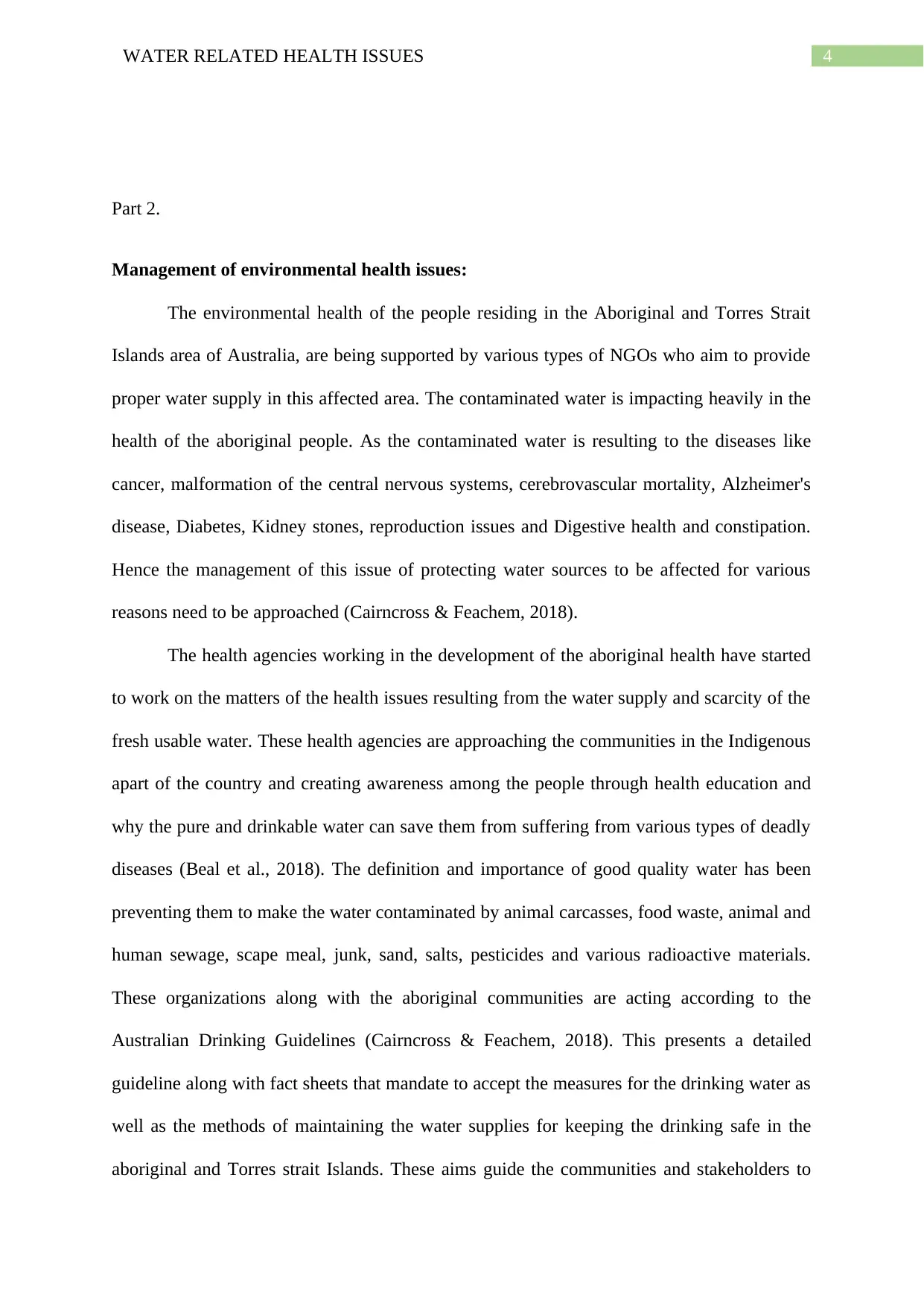
4WATER RELATED HEALTH ISSUES
Part 2.
Management of environmental health issues:
The environmental health of the people residing in the Aboriginal and Torres Strait
Islands area of Australia, are being supported by various types of NGOs who aim to provide
proper water supply in this affected area. The contaminated water is impacting heavily in the
health of the aboriginal people. As the contaminated water is resulting to the diseases like
cancer, malformation of the central nervous systems, cerebrovascular mortality, Alzheimer's
disease, Diabetes, Kidney stones, reproduction issues and Digestive health and constipation.
Hence the management of this issue of protecting water sources to be affected for various
reasons need to be approached (Cairncross & Feachem, 2018).
The health agencies working in the development of the aboriginal health have started
to work on the matters of the health issues resulting from the water supply and scarcity of the
fresh usable water. These health agencies are approaching the communities in the Indigenous
apart of the country and creating awareness among the people through health education and
why the pure and drinkable water can save them from suffering from various types of deadly
diseases (Beal et al., 2018). The definition and importance of good quality water has been
preventing them to make the water contaminated by animal carcasses, food waste, animal and
human sewage, scape meal, junk, sand, salts, pesticides and various radioactive materials.
These organizations along with the aboriginal communities are acting according to the
Australian Drinking Guidelines (Cairncross & Feachem, 2018). This presents a detailed
guideline along with fact sheets that mandate to accept the measures for the drinking water as
well as the methods of maintaining the water supplies for keeping the drinking safe in the
aboriginal and Torres strait Islands. These aims guide the communities and stakeholders to
Part 2.
Management of environmental health issues:
The environmental health of the people residing in the Aboriginal and Torres Strait
Islands area of Australia, are being supported by various types of NGOs who aim to provide
proper water supply in this affected area. The contaminated water is impacting heavily in the
health of the aboriginal people. As the contaminated water is resulting to the diseases like
cancer, malformation of the central nervous systems, cerebrovascular mortality, Alzheimer's
disease, Diabetes, Kidney stones, reproduction issues and Digestive health and constipation.
Hence the management of this issue of protecting water sources to be affected for various
reasons need to be approached (Cairncross & Feachem, 2018).
The health agencies working in the development of the aboriginal health have started
to work on the matters of the health issues resulting from the water supply and scarcity of the
fresh usable water. These health agencies are approaching the communities in the Indigenous
apart of the country and creating awareness among the people through health education and
why the pure and drinkable water can save them from suffering from various types of deadly
diseases (Beal et al., 2018). The definition and importance of good quality water has been
preventing them to make the water contaminated by animal carcasses, food waste, animal and
human sewage, scape meal, junk, sand, salts, pesticides and various radioactive materials.
These organizations along with the aboriginal communities are acting according to the
Australian Drinking Guidelines (Cairncross & Feachem, 2018). This presents a detailed
guideline along with fact sheets that mandate to accept the measures for the drinking water as
well as the methods of maintaining the water supplies for keeping the drinking safe in the
aboriginal and Torres strait Islands. These aims guide the communities and stakeholders to
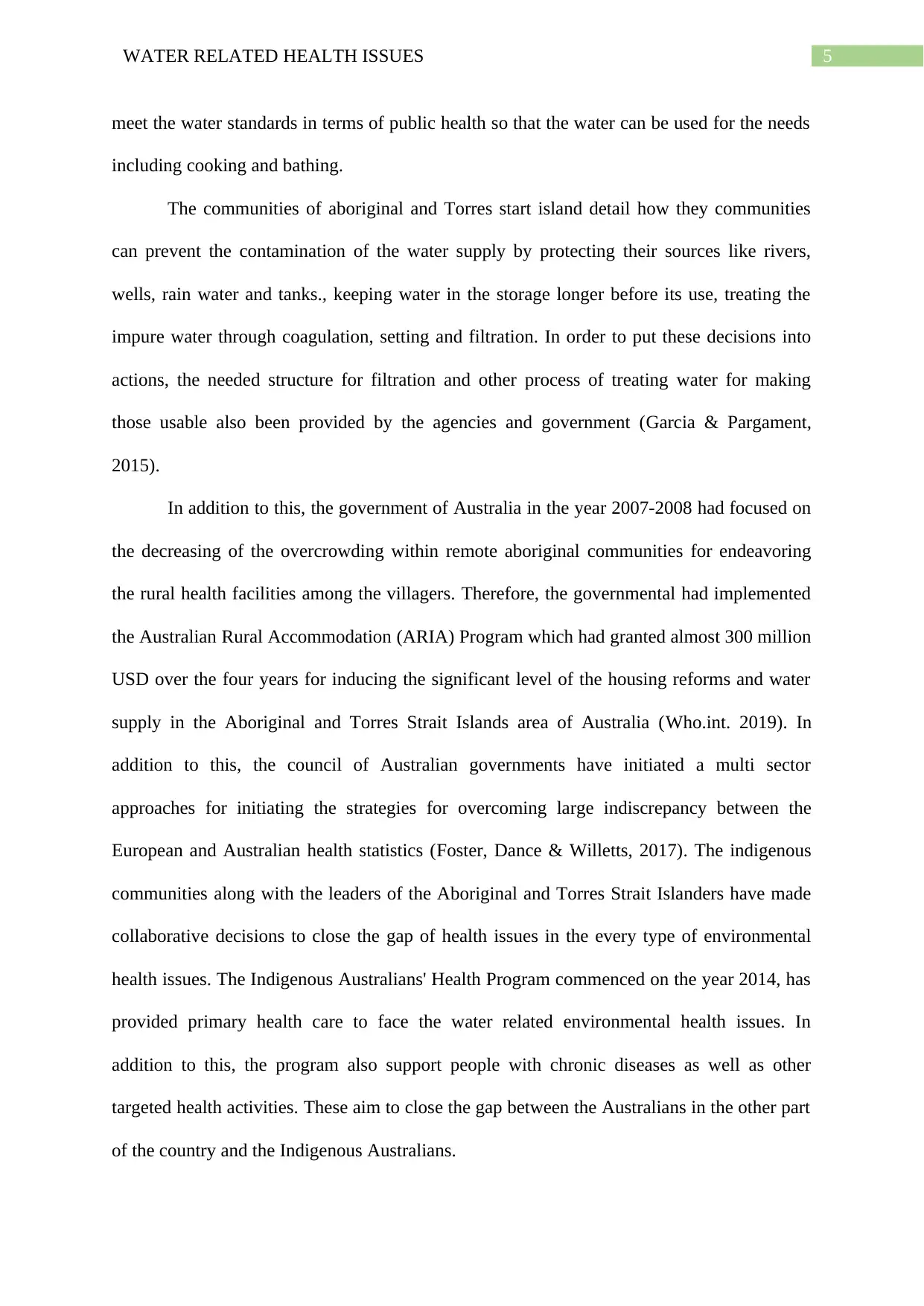
5WATER RELATED HEALTH ISSUES
meet the water standards in terms of public health so that the water can be used for the needs
including cooking and bathing.
The communities of aboriginal and Torres start island detail how they communities
can prevent the contamination of the water supply by protecting their sources like rivers,
wells, rain water and tanks., keeping water in the storage longer before its use, treating the
impure water through coagulation, setting and filtration. In order to put these decisions into
actions, the needed structure for filtration and other process of treating water for making
those usable also been provided by the agencies and government (Garcia & Pargament,
2015).
In addition to this, the government of Australia in the year 2007-2008 had focused on
the decreasing of the overcrowding within remote aboriginal communities for endeavoring
the rural health facilities among the villagers. Therefore, the governmental had implemented
the Australian Rural Accommodation (ARIA) Program which had granted almost 300 million
USD over the four years for inducing the significant level of the housing reforms and water
supply in the Aboriginal and Torres Strait Islands area of Australia (Who.int. 2019). In
addition to this, the council of Australian governments have initiated a multi sector
approaches for initiating the strategies for overcoming large indiscrepancy between the
European and Australian health statistics (Foster, Dance & Willetts, 2017). The indigenous
communities along with the leaders of the Aboriginal and Torres Strait Islanders have made
collaborative decisions to close the gap of health issues in the every type of environmental
health issues. The Indigenous Australians' Health Program commenced on the year 2014, has
provided primary health care to face the water related environmental health issues. In
addition to this, the program also support people with chronic diseases as well as other
targeted health activities. These aim to close the gap between the Australians in the other part
of the country and the Indigenous Australians.
meet the water standards in terms of public health so that the water can be used for the needs
including cooking and bathing.
The communities of aboriginal and Torres start island detail how they communities
can prevent the contamination of the water supply by protecting their sources like rivers,
wells, rain water and tanks., keeping water in the storage longer before its use, treating the
impure water through coagulation, setting and filtration. In order to put these decisions into
actions, the needed structure for filtration and other process of treating water for making
those usable also been provided by the agencies and government (Garcia & Pargament,
2015).
In addition to this, the government of Australia in the year 2007-2008 had focused on
the decreasing of the overcrowding within remote aboriginal communities for endeavoring
the rural health facilities among the villagers. Therefore, the governmental had implemented
the Australian Rural Accommodation (ARIA) Program which had granted almost 300 million
USD over the four years for inducing the significant level of the housing reforms and water
supply in the Aboriginal and Torres Strait Islands area of Australia (Who.int. 2019). In
addition to this, the council of Australian governments have initiated a multi sector
approaches for initiating the strategies for overcoming large indiscrepancy between the
European and Australian health statistics (Foster, Dance & Willetts, 2017). The indigenous
communities along with the leaders of the Aboriginal and Torres Strait Islanders have made
collaborative decisions to close the gap of health issues in the every type of environmental
health issues. The Indigenous Australians' Health Program commenced on the year 2014, has
provided primary health care to face the water related environmental health issues. In
addition to this, the program also support people with chronic diseases as well as other
targeted health activities. These aim to close the gap between the Australians in the other part
of the country and the Indigenous Australians.
⊘ This is a preview!⊘
Do you want full access?
Subscribe today to unlock all pages.

Trusted by 1+ million students worldwide
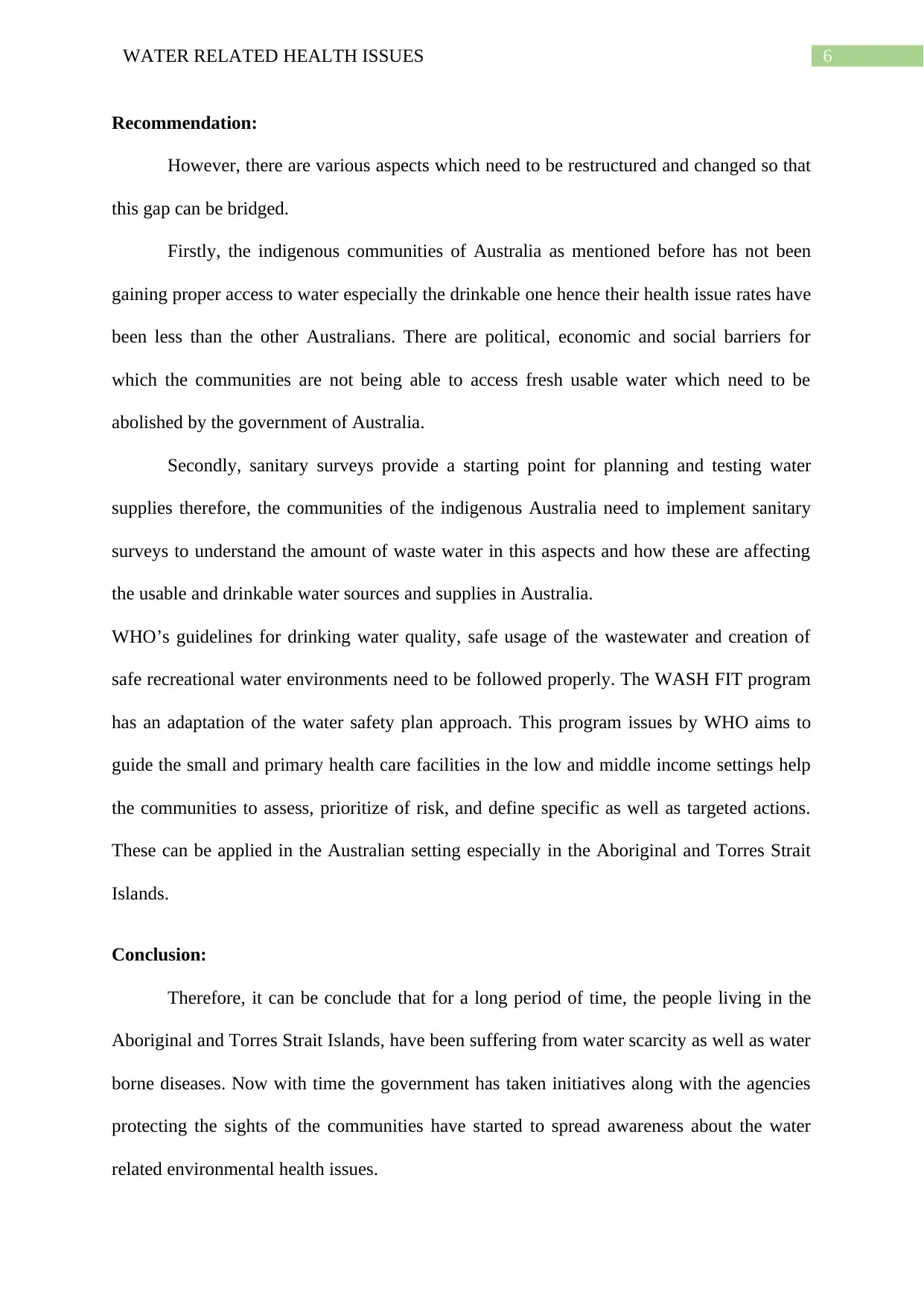
6WATER RELATED HEALTH ISSUES
Recommendation:
However, there are various aspects which need to be restructured and changed so that
this gap can be bridged.
Firstly, the indigenous communities of Australia as mentioned before has not been
gaining proper access to water especially the drinkable one hence their health issue rates have
been less than the other Australians. There are political, economic and social barriers for
which the communities are not being able to access fresh usable water which need to be
abolished by the government of Australia.
Secondly, sanitary surveys provide a starting point for planning and testing water
supplies therefore, the communities of the indigenous Australia need to implement sanitary
surveys to understand the amount of waste water in this aspects and how these are affecting
the usable and drinkable water sources and supplies in Australia.
WHO’s guidelines for drinking water quality, safe usage of the wastewater and creation of
safe recreational water environments need to be followed properly. The WASH FIT program
has an adaptation of the water safety plan approach. This program issues by WHO aims to
guide the small and primary health care facilities in the low and middle income settings help
the communities to assess, prioritize of risk, and define specific as well as targeted actions.
These can be applied in the Australian setting especially in the Aboriginal and Torres Strait
Islands.
Conclusion:
Therefore, it can be conclude that for a long period of time, the people living in the
Aboriginal and Torres Strait Islands, have been suffering from water scarcity as well as water
borne diseases. Now with time the government has taken initiatives along with the agencies
protecting the sights of the communities have started to spread awareness about the water
related environmental health issues.
Recommendation:
However, there are various aspects which need to be restructured and changed so that
this gap can be bridged.
Firstly, the indigenous communities of Australia as mentioned before has not been
gaining proper access to water especially the drinkable one hence their health issue rates have
been less than the other Australians. There are political, economic and social barriers for
which the communities are not being able to access fresh usable water which need to be
abolished by the government of Australia.
Secondly, sanitary surveys provide a starting point for planning and testing water
supplies therefore, the communities of the indigenous Australia need to implement sanitary
surveys to understand the amount of waste water in this aspects and how these are affecting
the usable and drinkable water sources and supplies in Australia.
WHO’s guidelines for drinking water quality, safe usage of the wastewater and creation of
safe recreational water environments need to be followed properly. The WASH FIT program
has an adaptation of the water safety plan approach. This program issues by WHO aims to
guide the small and primary health care facilities in the low and middle income settings help
the communities to assess, prioritize of risk, and define specific as well as targeted actions.
These can be applied in the Australian setting especially in the Aboriginal and Torres Strait
Islands.
Conclusion:
Therefore, it can be conclude that for a long period of time, the people living in the
Aboriginal and Torres Strait Islands, have been suffering from water scarcity as well as water
borne diseases. Now with time the government has taken initiatives along with the agencies
protecting the sights of the communities have started to spread awareness about the water
related environmental health issues.
Paraphrase This Document
Need a fresh take? Get an instant paraphrase of this document with our AI Paraphraser

7WATER RELATED HEALTH ISSUES
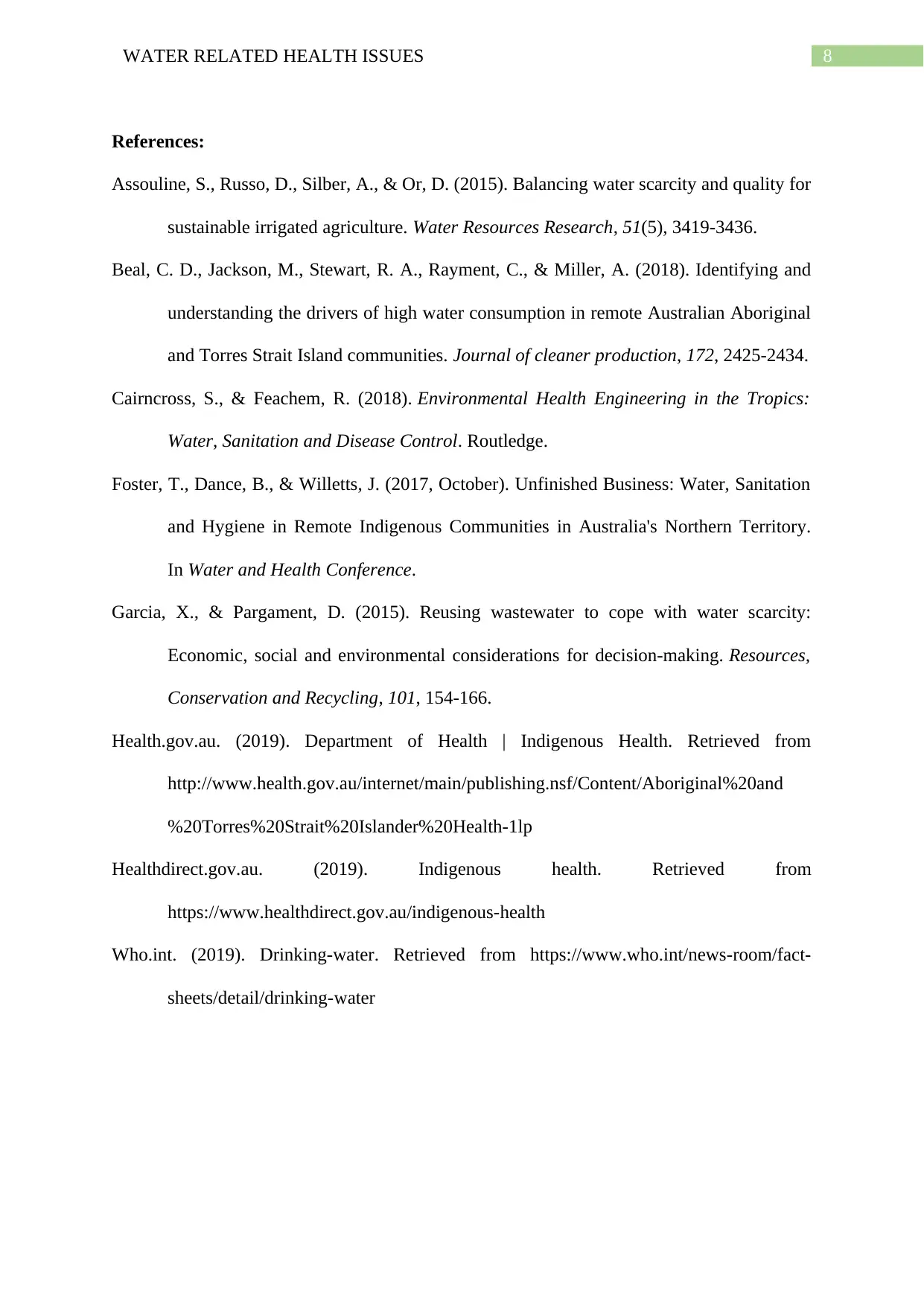
8WATER RELATED HEALTH ISSUES
References:
Assouline, S., Russo, D., Silber, A., & Or, D. (2015). Balancing water scarcity and quality for
sustainable irrigated agriculture. Water Resources Research, 51(5), 3419-3436.
Beal, C. D., Jackson, M., Stewart, R. A., Rayment, C., & Miller, A. (2018). Identifying and
understanding the drivers of high water consumption in remote Australian Aboriginal
and Torres Strait Island communities. Journal of cleaner production, 172, 2425-2434.
Cairncross, S., & Feachem, R. (2018). Environmental Health Engineering in the Tropics:
Water, Sanitation and Disease Control. Routledge.
Foster, T., Dance, B., & Willetts, J. (2017, October). Unfinished Business: Water, Sanitation
and Hygiene in Remote Indigenous Communities in Australia's Northern Territory.
In Water and Health Conference.
Garcia, X., & Pargament, D. (2015). Reusing wastewater to cope with water scarcity:
Economic, social and environmental considerations for decision-making. Resources,
Conservation and Recycling, 101, 154-166.
Health.gov.au. (2019). Department of Health | Indigenous Health. Retrieved from
http://www.health.gov.au/internet/main/publishing.nsf/Content/Aboriginal%20and
%20Torres%20Strait%20Islander%20Health-1lp
Healthdirect.gov.au. (2019). Indigenous health. Retrieved from
https://www.healthdirect.gov.au/indigenous-health
Who.int. (2019). Drinking-water. Retrieved from https://www.who.int/news-room/fact-
sheets/detail/drinking-water
References:
Assouline, S., Russo, D., Silber, A., & Or, D. (2015). Balancing water scarcity and quality for
sustainable irrigated agriculture. Water Resources Research, 51(5), 3419-3436.
Beal, C. D., Jackson, M., Stewart, R. A., Rayment, C., & Miller, A. (2018). Identifying and
understanding the drivers of high water consumption in remote Australian Aboriginal
and Torres Strait Island communities. Journal of cleaner production, 172, 2425-2434.
Cairncross, S., & Feachem, R. (2018). Environmental Health Engineering in the Tropics:
Water, Sanitation and Disease Control. Routledge.
Foster, T., Dance, B., & Willetts, J. (2017, October). Unfinished Business: Water, Sanitation
and Hygiene in Remote Indigenous Communities in Australia's Northern Territory.
In Water and Health Conference.
Garcia, X., & Pargament, D. (2015). Reusing wastewater to cope with water scarcity:
Economic, social and environmental considerations for decision-making. Resources,
Conservation and Recycling, 101, 154-166.
Health.gov.au. (2019). Department of Health | Indigenous Health. Retrieved from
http://www.health.gov.au/internet/main/publishing.nsf/Content/Aboriginal%20and
%20Torres%20Strait%20Islander%20Health-1lp
Healthdirect.gov.au. (2019). Indigenous health. Retrieved from
https://www.healthdirect.gov.au/indigenous-health
Who.int. (2019). Drinking-water. Retrieved from https://www.who.int/news-room/fact-
sheets/detail/drinking-water
⊘ This is a preview!⊘
Do you want full access?
Subscribe today to unlock all pages.

Trusted by 1+ million students worldwide
1 out of 9
Related Documents
Your All-in-One AI-Powered Toolkit for Academic Success.
+13062052269
info@desklib.com
Available 24*7 on WhatsApp / Email
![[object Object]](/_next/static/media/star-bottom.7253800d.svg)
Unlock your academic potential
Copyright © 2020–2025 A2Z Services. All Rights Reserved. Developed and managed by ZUCOL.





